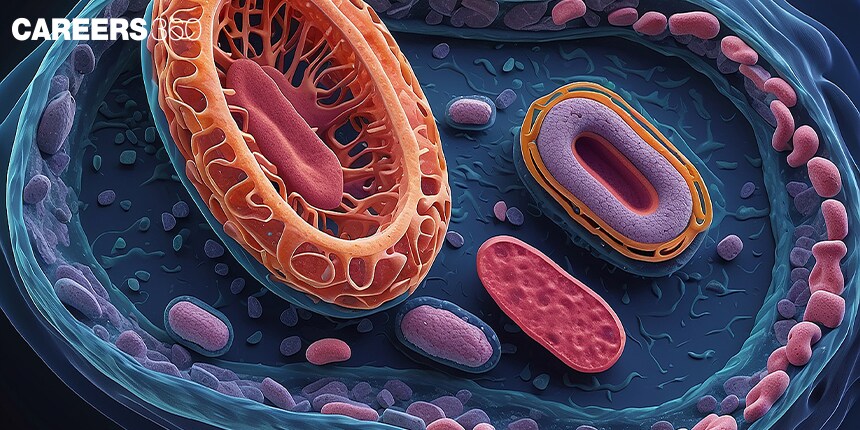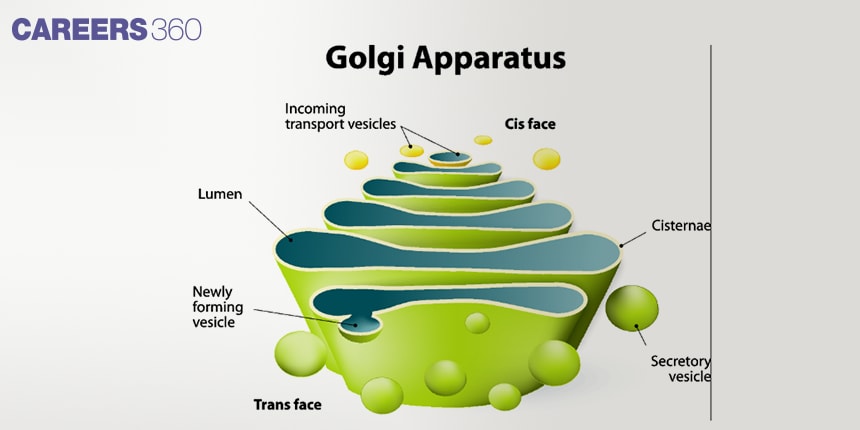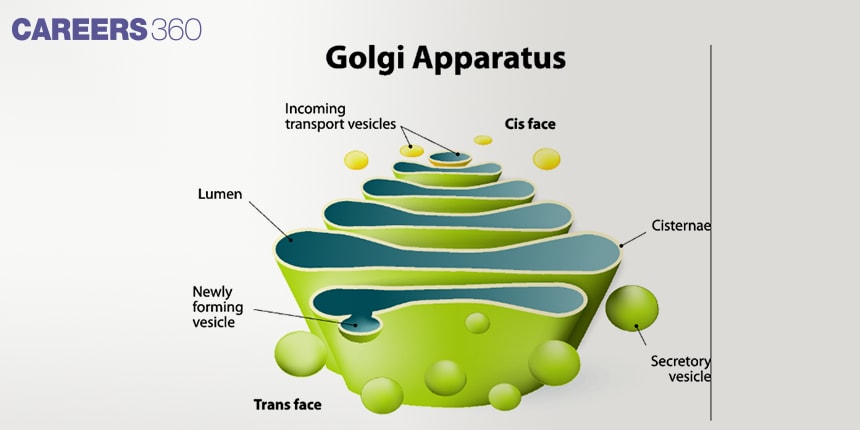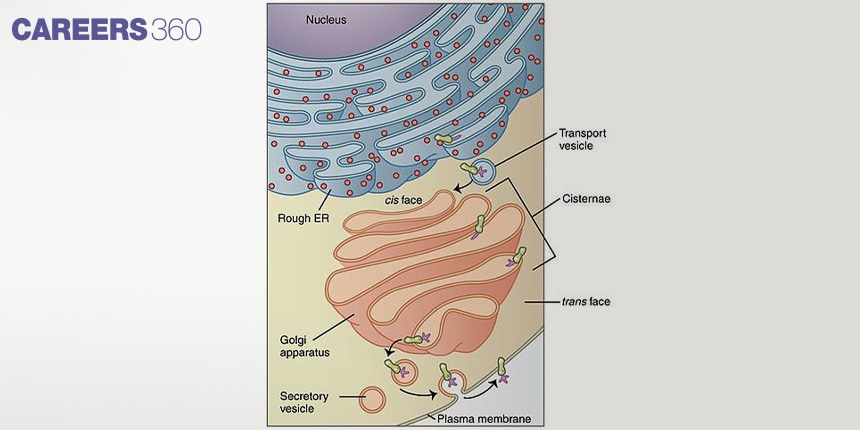Golgi apparatus: Definition, Types, Examples, Diagram, Function
The Golgi apparatus is defined as an important eukaryotic organelle that contains a series of flattened membrane-bound sacs that are responsible for the activities of processing, sorting, and packing proteins and lipids before they are sent to other parts of the cell or to the outside environment. Golgi apparatus is a topic of the chapter Cell: The Unit of Life in Biology.
NEET 2025: Mock Test Series | Syllabus | High Scoring Topics | PYQs
NEET Important PYQ's Subject wise: Physics | Chemistry | Biology
New: Meet Careers360 B.Tech/NEET Experts in your City | Book your Seat now
- Golgi Apparatus Definition
- Historical Background
- Golgi Apparatus Structure
- Golgi Apparatus Function
- Dynamics and Regulation of the Golgi Apparatus
- Biogenesis and Maintenance of the Golgi Apparatus
- Applications and Relevance
- Recommended video for Golgi Apparatus

Golgi Apparatus Definition
Definition of Golgi apparatus: Eukaryotic cell organelle; stack of flattened membrane-bound sacs known as cisternae. It appears to play a critical role in the alteration, categorization, and direction of proteins and lipids which are retrieved from the endoplasmic reticulum to a suitable position in the cell or outside it.
Historical Background
The Golgi apparatus was discovered by Italian scientist Camillo Golgi in 1898 employing a new staining method. Subsequently, research has added more information to the body of knowledge regarding this organelle mainly to reveal the fact that the Golgi apparatus is a significant player in the secretory processes, protein synthesis, and restoring the structural and functional order of the cell.
Golgi Apparatus Structure
The structure of the Golgi Apparatus is described below-
General Structure
The Golgi body is a system of flattened sacs known as cisternae but it is actually a collection of organelles. These cisternae are organized into three main regions: With regard to the biochemical function, these regions include the cis, medial, and trans portions of the protein.

Functional Zones
Cis-Golgi Network (CGN): This is the side of the Golgi apparatus through which it receives vesicles from the ER more commonly called the delivery side.
Medial-Golgi: The location where most changes of proteins and lipids are done.
Trans-Golgi Network (TGN): The exit face, molecules that are sorted and modified are packaged into vesicles and transported to various destinations.

Also Read-
Golgi Apparatus Function
The functions of the golgi apparatus are described below-
Protein Modification
Glycosylation and phosphorylation: The various proteins are transported to the Golgi apparatus for glycosylation which involves the addition of sugar groups and phosphorylation which involves the attachment of phosphate groups to proteins.
Sorting and packaging of proteins: Proteins are moved and bundled in the vesicles ready to be sent to different parts of the cell.
Lipid Transport and Metabolism
Role in lipid sorting and processing: This organelle plays a role in sorting and packaging lipids and coordinating on where they would be delivered.
Significance in membrane biogenesis: It has an important function of lipid synthesis which provides a means for the formation of cell membranes.
Polysaccharide Synthesis
Synthesis of cell wall components in plants: Complex polysaccharides that form the plant cell wall are synthesized by the Golgi apparatus and secreted out from the cell.
Role in producing extracellular matrix in animal cells: It synthesizes glycosaminoglycans and proteoglycans which are major matrices of the extracellular matrix.
Vesicular Transport
Formation of vesicles: The Golgi apparatus sorts proteins and lipids into vesicles that are to be delivered to their appropriate destinations.
Dynamics and Regulation of the Golgi Apparatus
The dynamics and functional regulation of the Golgi Apparatus is described below-
Interconnectedness with ER and Other Organelles
Transport from ER to Golgi: ER products, proteins, and lipids, are shipped to the Golgi apparatus through vesicles that are formed and bud off the ER, fusing with the cisternae of the cis-Golgi network.
Interaction with lysosomes and plasma membrane: They process, sort, and package proteins and lipids that are to be sent to lysosomes or plasma membrane or that are to be secreted. These molecules are transported on vesicles originating from the trans-Golgi network (TGN) to their appropriate locations.

Regulatory Mechanisms
Role of signalling pathways and molecular mechanisms: Signaling molecules control the actions of the Golgi apparatus some of which are Rab and Arf GTPases involved in vesicle formation.
Adaptation to cellular needs and stress: This organelle can also respond to other conditions of the cell, for instance, when production and secretion of proteins or when stressed, the Golgi apparatus modifies it to ensure that the condition of the cell is received well.
Biogenesis and Maintenance of the Golgi Apparatus
The Biogenesis and Maintenance of the Golgi Apparatus is described below-
Formation of Golgi Apparatus
Origin and development in cells: The Golgi apparatus develops from some vesicles that come from the endoplasmic reticulum (ER). These form vesicles, which come together to form the cis-Golgi, transforming into the medial-Golgi, and finally the trans-Golgi, which is involved in the packaging and shipment of products in the body.
Genetic and environmental factors influencing Golgi formation: The structure and activity of the Golgi apparatus are regulated by multiple genetic factors: the presence of genes encoding Golgi matrix proteins and enzymes of vesicular traffic. External factors regulate the internal signalling pathways that are involved in the process of Golgi movement and formation depending on nutrient access and other cellular stressors.
Maintenance and Structural Integrity
Processes ensuring structural and functional integrity: The structure and function of the Golgi apparatus are constantly undergoing a process of vesicle budding and fusion through the assistance of coat protein complexes including COPI as well as COPII. There is therefore constant traffic of vesicles that role in the replacement and distribution of Golgi enzymes and other resident proteins.
Role of Golgi matrix proteins: The proteins included in the GM are also referred to as GRASPs (Golgi reassembly and stacking proteins) and golgins which are important in sustaining the structural organization and nesting of the cisternae.
Applications and Relevance
The Applications and Relevance of the Golgi Apparatus are described below-
Medical and Biotechnological Applications
Role in disease mechanisms: The Golgi apparatus plays an essential role in the study of diseases, and such classification includes genetic diseases and cancerous diseases. Defects in most components of the Golgi apparatus result in incompetent protein folding and sorting and this causes various diseases such as the congenital disorders of glycosylation and even some types of cancer in which the rates of glycosylation affect signaling and tumor growth.
Use in drug development and genetic engineering: It has been a subject of the drug and genetic engineering process since the delivery and efficiency of therapeutic proteins are hastened in the Golgi apparatus. Knowing about how it takes part in protein modification and sorting is useful in coming up with strategies for generating recombinant proteins with the right glycosylation challenges, enhancing the stability and activity of these proteins in their status as drugs.
Relevance in Cellular and Molecular Biology
Importance for students and researchers: Golgi apparatus is an important concept in the curriculum of cell and molecular biology as well as handy for learners and scholars in cell biology and protein chemistry classes. Due to its involvement in changing, arranging, and boxing proteins and lipids, its study is very useful in understanding cell functions, disease processes, and possible treatments.
Also Read-
Recommended video for Golgi Apparatus
Frequently Asked Questions (FAQs)
This organelle serves as the cell’s packaging department; after the proteins and lipids have been made in the ER, they are shipped here for further processing and sent to their final location in the cell.
After proteins are synthesized and enter the Golgi apparatus they can be modified in several ways such as glycosylation, phosphorylation & sulfation all of which occur catalytically in the Golgi enzymes. These changes affect favorably the functional properties, thermostability, and cellular recognition of functional proteins.
The Golgi apparatus is involved in vesicular transport where it accepts cargo from the ER, modifies it, and then sorts it to different parts of the cell like lysosomes, secretory vesicles, or plasma membrane.
The Golgi apparatus communicates with the endoplasmic reticulum with the use of vesicles, in both ways. It also receives transport vesicles with cargo from the ER and in turn supplies vesicles with modified proteins or lipids for reuse/endocytosis.
This organelle is composed of three zones, cis-Golgi network, medial-Golgi, and trans-Golgi network all of which play functional roles in processing, sorting, and trafficking proteins in the cell. The cis-Golgi network accepts cargo from the ER the medial-Golgi re-modifies proteins and the trans-Golgi network targets proteins into vesicles of various types for distribution throughout the cell.
Also Read
27 Dec'24 05:51 PM
23 Nov'24 05:46 PM
08 Nov'24 05:04 PM
08 Nov'24 10:59 AM
08 Nov'24 09:54 AM
08 Nov'24 09:26 AM
08 Nov'24 09:01 AM
07 Nov'24 10:17 PM
07 Nov'24 09:50 PM
07 Nov'24 04:38 PM